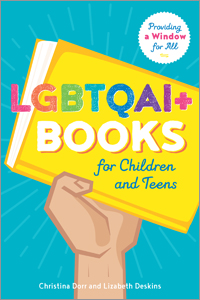LGBTQAI+ books for children and teens: an interview with Christina Dorr and Liz Deskins
There is a rich and varied body of literature for lesbian, gay, bisexual, transgender, queer/questioning, asexual/allied and intersexed young people; in fact, within the past decade there has been a veritable explosion of new titles. A new book, LGBTQAI+ Books for Children and Teens: Providing a Window for All, surveys the landscape, not only spotlighting dozens of recommended books but also offering guidance on how to share them with young people. We caught up with authors Christina Dorr and Liz Deskins to talk with them about how their book came together, ways in which reading builds empathy, and some "desert island" picks for their favorite LGBTQAI+ lit.
So, this is your second book together. What was the genesis of the project? Was anything different about your collaboration this time around?
We are both passionate about human rights issues, and gay rights is a large part of that. It was amazing  serendipity that we were at the ALA Annual conference in San Francisco in 2015 on the day the Supreme Court handed down the ruling making marriage legal for same sex couples. We saw the celebrations in the streets and the Pride Parade, and realized that the time had come to provide a resource that would support and encourage public and school librarians, as well as classroom teachers to provide and share quality LGBTQAI+ literature with their patrons and students. This book was an amazing collaboration, as we both worked on all chapters, adding titles and annotations. Some of the ancillary portions, we divided and conquered.
serendipity that we were at the ALA Annual conference in San Francisco in 2015 on the day the Supreme Court handed down the ruling making marriage legal for same sex couples. We saw the celebrations in the streets and the Pride Parade, and realized that the time had come to provide a resource that would support and encourage public and school librarians, as well as classroom teachers to provide and share quality LGBTQAI+ literature with their patrons and students. This book was an amazing collaboration, as we both worked on all chapters, adding titles and annotations. Some of the ancillary portions, we divided and conquered.
Why is this topic so personally important to both of you?
This book was truly a labor of love for both of us. We each have someone near and dear to us in the gay community and saw the challenges they faced growing up. In a joyous event last summer, Liz's son married his partner in a legal marriage. As school librarians we do our best to choose books to be windows and doors for all of our students. We believe in the power of empathy and understanding through good literature, and are hopeful this book will encourage other librarians to make these books available as well.
You've mentioned that LGBTQAI+ books act as mirrors and windows - what do you mean by that?
This is a concept put forward by Ohio State University professor emeritus, Rudine Sims Bishop, under which we both studied. She contends that It is so important for children to be able to see themselves in  books, to know that they are not alone. But it is just as important they read books where they see characters different from themselves. Reading builds empathy and understanding, two qualities worth cultivating.
books, to know that they are not alone. But it is just as important they read books where they see characters different from themselves. Reading builds empathy and understanding, two qualities worth cultivating.
What advice can you offer libraries that are dealing with community objections to LGBTQAI+ books or outreach? Or who may be self-censoring to avoid potential conflicts?
Our job is not to only promote those books we like or find interesting; our job is to present a whole and balanced curated collection of materials. In this case, the issue is respect and basic human rights for everyone. Sexuality and gender identity are types of diversity, among many, but neither of these are the impetus of for this book, or the books we suggest. Everyone has a right to see themselves in a book, or their family, or their friends. And everyone has the right to be treated with understanding, empathy, and respect. Our book shares quality titles, conversation starters, and other resources that could assist in the defense of the book, if you should need it.
Okay, desert island time! If you could choose only three LGBTQAI+ titles to recommend, what would they be?
Christina's picks: This Day in June by Gayle E. Pitman (for young children), The Best Man by Richard Peck (for middle grade children), and Queer, Here, There, and Everywhere by Sarah Prager (for teens); Liz's picks: The Straight Line Wonder by Mem Fox (for young children), The Misfits by James Howe (for middle grade children), and Boy Meets Boy by David Levithan (for high school).
Learn more about the book at the ALA Store.
